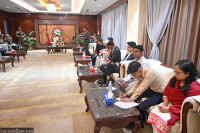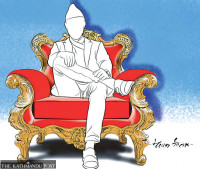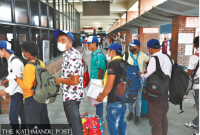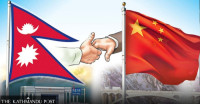Opinion
Water at midnight
Water is the symbol of anything that we hope for in recent times; it is culture, memory and history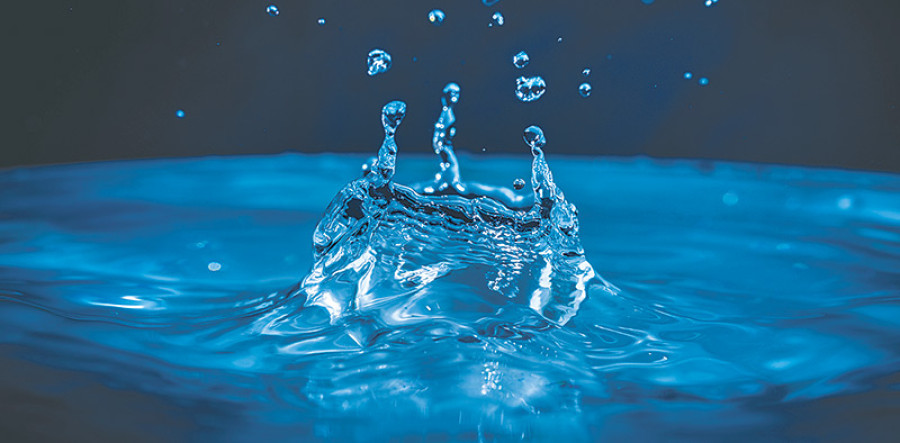
Kathmandu city, a dusty bowl, wakes up suddenly at midnight, aroused by a strange brouhaha. Voices are calling from different directions informing people that water has started flowing from the perennially dry taps, and everybody should get ready to make the best use of the water thus flowing! A choric voice says, “oh people, wake up from the sleep of this time river!” The voice also advises people about harvesting as much water as they can in “buckets, pitchers, jerrycans, plastic tubs, bottles and glasses.” Suddenly a semantically unusual suggestion tears out of the din, “carry all the empty vessels of life” for “your city is singing its original folk melody”. The voice assumes a prophetic tone with this mundane suggestion to clean up what lay dirty so far because there has never been any supply of water in modern Kathmandu. This call sounds particularly moving—“Take out your dirty clothes wet with the cold tears of history! Bring out your vests that smell of labour, and loin clothes! Take out your wives’ clothes used in confinements! Bring out smelly socks like thoughts!” People desperately start to pump more water by using motors that start wailing in the landlords’ courtyards like thirsty eagles. The reason is, water has started flowing from the taps after years of scorching.
Life force
The choric voice turns very poetic, and uses allusions from poet Bairagi Kanhila’s famous poem “Mateko mancheko bhasan, madyaratpachiko sadaksita” or “an inebriated man’s speech given to a street after the midnight” in which he calls on the street to expand so that he can take the children to school easily the following day. Kanhila uses the allusion from the Mahabharata in which Bharat brings the river Ganga from heaven to flow on the spot where his 60,000 brothers were turned into ashes by the flames that came out of the eyes of Rishi Kapil who was angry with them for insulting him in his meditation. Our narrator brilliantly turns that allusion into a contemporaneous reality. He says, “Oh, thousand cursed sons of Sagar, Rise from the heat of your own ashes! You have to save life drop by drop!” And adds with a force of irony, they “have to sing national anthem by drinking the self-same water!” These lines are particularly very strong—“Get the children out of their beds quickly! Otherwise”, he questions, “how will they turn the pages of history with their dirty fingers in schools tomorrow, and face the caning from teachers?” The chorus knows, “We were defeated by small troubles for seeing only big dreams!”
I translated the above lines from a recently published Nepali poem written by poet Viplab Dhakal, which I found in a newspaper, at a time when I was struggling with the phenomenology of procrastination in Nepali water supply works. The poem gives an absurd mythic quality of delay, of doing nothing that has nearly stagnated Nepali society. Melamchi water delay has a symbiotic relationship with the inconclusive modes of Nepali politics. The poem links the need to clean up life, education, culture and health with water. Here, water is the symbol of anything that we hope for in recent times. The history of Melamchi’s absurdity neatly synchronises with the transition and experiment period of Nepali political transformations. Two things come up here. I have space to only just mention them.
The first is the nagging question, a psyche that has caused the non-action of the Melamchi water supply in Kathmandu Valley. It is also symbolic and psychological. As a theatre person, I have compared Melamchi with Samuel Beckett’s absurd play “Waiting for Godot” in this newspaper (03/09/2017). Theorising the more than 10-year delay to the Melamchi Water Supply Project in Kathmandu, Leon Ching of National University of Singapore explaining it in “water infrastructure provision in Kathmandu” (Water Alternatives 11(1): 61-85) says, to put it in simple terms, there are two reasons for this. The first is, governments avoid it because it has low payoff, and it only brings blame. The second, or the more difficult part is that they develop “self-perception of resilience” generated by the act of coping with natural disasters. It is a very good analysis. We can explain the Nepali governments’ response to the earthquake disaster with this very reason—it brings blame and does not bring enough payoff.
Symbol of regeneration
Water is culture, memory and history in the Valley. Water architecture is the most unique feature of water supply heritage here. Water architecture can be seen in the construction of ponds, tube wells, rajkulos and hitis with stone spouts. The last two have remained the main sources of water supply, dating back to the Licchavi and continuing through the Malla and Shah periods in history. But now the perennial sources of water are drying up, and people have no choice but to resort to the boring system, which as the geologists say, has its own hazards.
Not being an expert on this subject, I want to return to the poem and its message, which is, people are left hoping for a better life and respite from all kinds of problems in Kathmandu and other cities of Nepal. The resilience of the governments is a very serious matter, which represents a psyche of delaying, and looking for more payoffs as tacit motivating factors of engagement. The air quality of the Kathmandu Valley is a matter of great concern. Major cities of India too are in the grip of pollution, but the measures that they are taking shows one quality that is different from ours. We are not planning anything, only making it more difficult by the day.
The call made by the choric character is a dream of life, dream of simple supply of water to the city that lives without it. The poet has captured the euphoria expressed by people of Kathmandu city when they see the tickle of water coming from the tap. Symbolically, Nepali people are compelled to live with these conditions. Water is a symbol of regeneration, a process of rising from the ashes. The midnight hullabaloo is a moving reminder of our thwarted dreams of the water of life in history.




 19.12°C Kathmandu
19.12°C Kathmandu